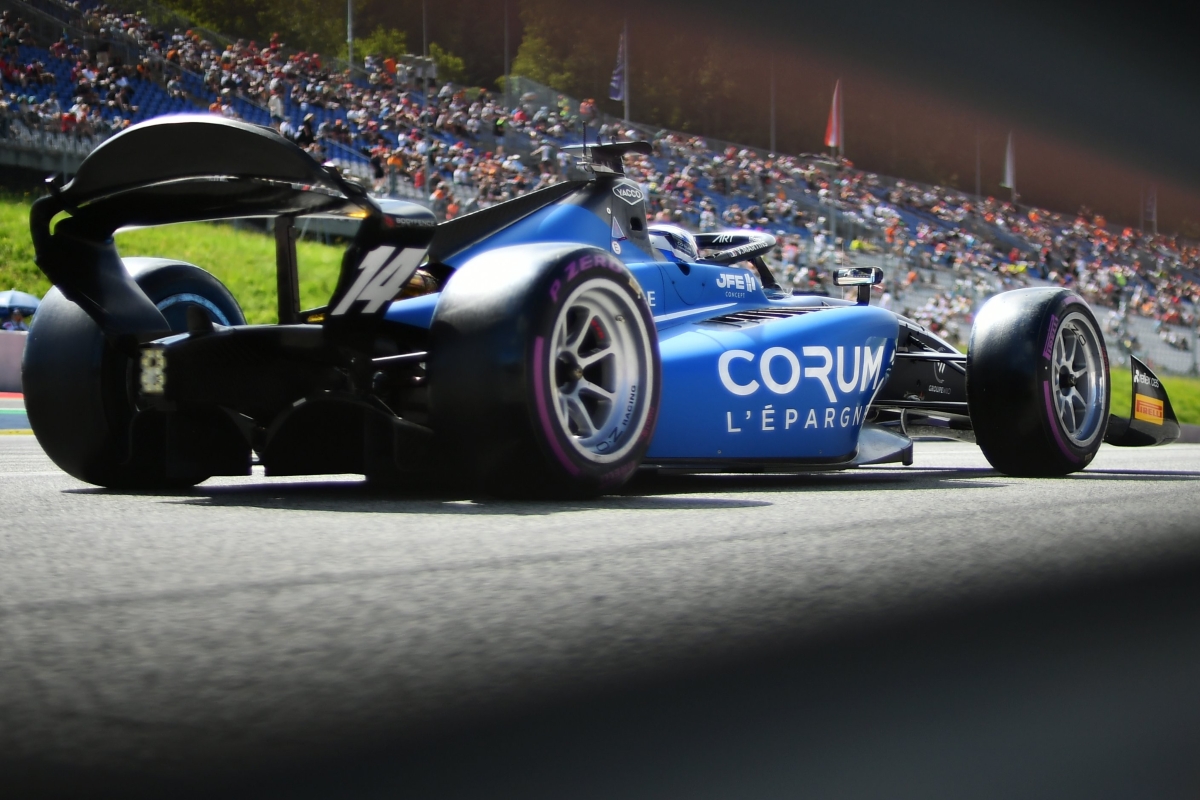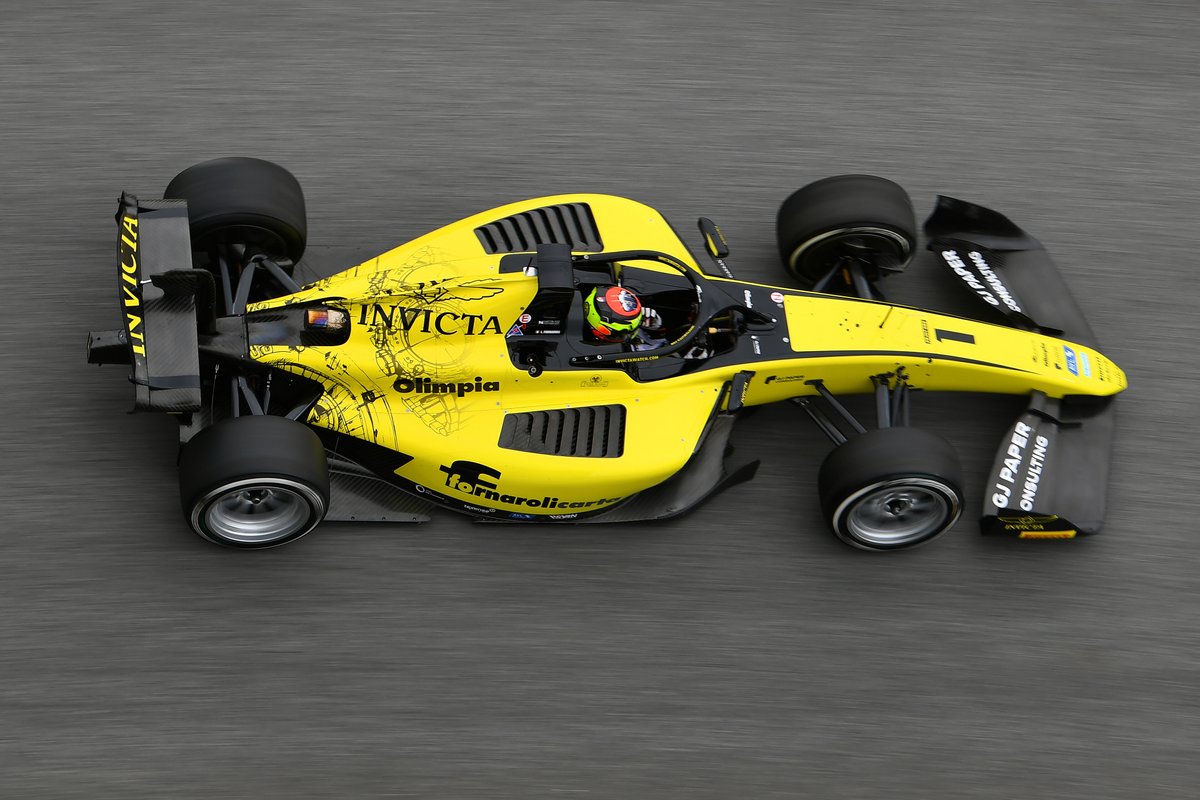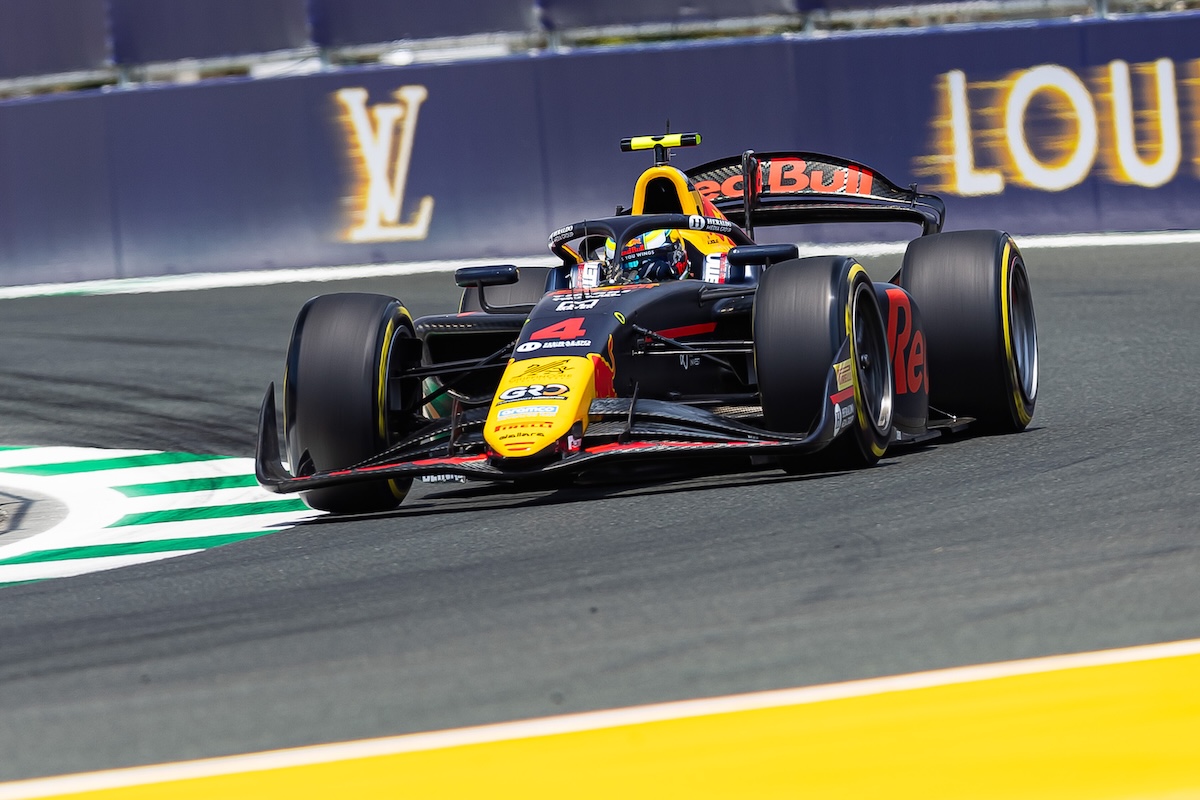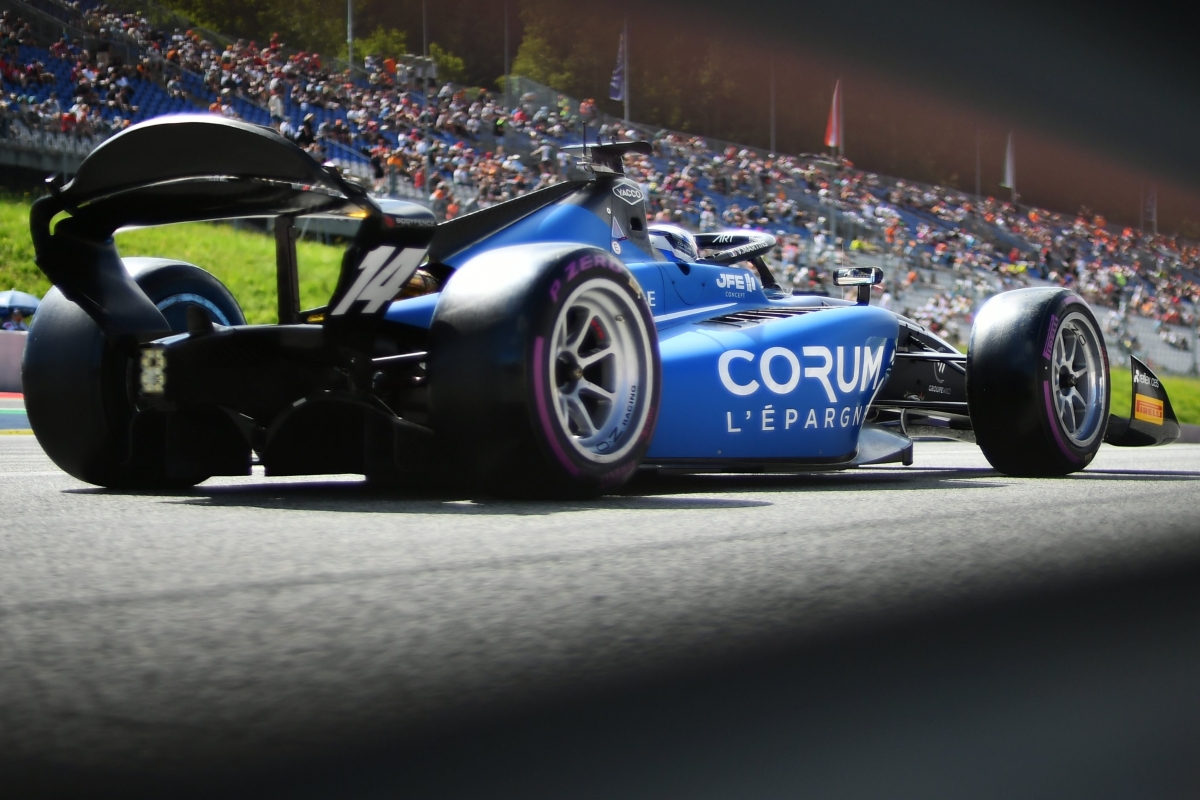13

Photos: Formula Motorsport Ltd
Halfway through F2’s season, disparity between teams’ qualifying and race pace has set up a great title fight
Since the Dallara F2 2024’s introduction, Formula 1’s primary feeder series has become less predictable and the championship table has been less representative of teams’ competitiveness let alone the difference between drivers’ abilities.
There have been different approaches to getting the most out of Formula 2’s current chassis, and the upheaval of the pecking order that took place during the first year of its use has roughly continued into 2025.
Last weekend’s Red Bull Ring round marked the halfway point of the season, and the track was a perfect example of set-up variation. The high-speed, undulating corners mean downforce should be the priority, but most of the connecting parts are also acceleration zones so straightline speed is key too and that required low drag to be prioritised instead.
The influence of engine power and aerodynamics, particularly downforce since it is a low-pressure area underneath the car compared to the higher pressure air above, also takes on a different value at the Red Bull Ring since the circuit is at high altitude where air pressure everywhere is lower.
After filling the top three places in qualifying, Invicta Racing’s Leonardo Fornaroli, ART Grand Prix’s Victor Martins and MP Motorsport’s Richard Verschoor spoke to media including Formula Scout about the set-up differences currently seen in F2.
“I’ve been in a few different teams, and it’s true that there are many different philosophies in between teams,” said Verschoor.
“Some people focus more on the mechanical grip of the car. Some teams focus more on the downforce. So far I’ve been very strong on all the tracks that require a bit more downforce from the car. But you can see it from different teams, how they are performing. If it’s one car only on top or if there’s two cars in the front.”
Absolute pace
Pos
Driver
Team
Pace
Pos
Driver
Team
Pace
1
Martins
ART GP
100.161%
12
Beganovic
Hitech
100.743%
2
Dunne
Rodin
100.333%
13
Maini
DAMS
100.747%
3
Fornaroli
Invicta
100.358%
14
Marti
Campos
100.806%
4
Lindblad
Campos
100.480%
15
Miyata
ART GP
100.863%
5
Browning
Hitech
100.542%
16
Meguetounif
Trident
100.989%
6
Verschoor
MP
100.545%
17
Goethe
MP
101.034%
7
Mini
Prema
100.576%
18
Cordeel
Rodin
101.114%
8
Crawford
DAMS
100.579%
19
Villagomez
VAR
101.572%
9
Stanek
Invicta
100.582%
20
Bennett
VAR
101.606%
10
Montoya
Prema
100.594%
21
Esterson
Trident
101.708%
11
Duerksen
AIX
100.741%
22
Shields
AIX
102.299%
Third-year F2 driver Martins said ART GP has “been really strong in qualifying”, and the data backs that up as on average he is the quickest driver on single-lap pace in 2025.
“I felt really comfortable reaching the limits with the car and I’m extracting the most out of it. So definitely the car suits me for qualifying. And in the race I feel also like the [pace] was really strong. Some tracks we had a bit more tyre degradation, so maybe we are more aggressive on certain things.”
He added: “I will just try to maximise what I have every time, and give the team some good feedback to just focus on the right things. But definitely we have different philosophies [between teams].”
Martins noted that once he and his engineers are able to spot where rivals are quicker in different types of corners, it is not a case of trying to emulate their pace through going into the unknown on set-up but rather “you need to adapt to the car you have and stick with [your philosophy]”.
Fornaroli, an F2 rookie who has two poles already, has found Invicta revises the set-up more around its drivers than the other way around. ART GP’s comparative rigorousness may be due to Martins’ experience and past success in F2, since he knows better how to revise his driving to maximise to suit the parameters the car is set up to.
However it’s also down to ART GP prioritising set-ups that put Martins as far up the grid as possible, with a race pace cost. Cars can not only be optimised towards the grip levels of one tyre compound over another, but also based on what feedback a compound provides in qualifying – where there can be cooldown laps between flying laps – rather than over a whole stint.
Since Pirelli does not bring all compounds to every round, some data to inform set-up choices can only be accumulated later in the season and at a point where racing on two or three weekends in a row puts time constraints on what can be learned away from the track.
 “[Invicta] have a very open mind. They work very well with the drivers,” explained Fornaroli. “They’re happy to follow their requests, with the car. And we are always super strong in qualifying. It was always very comfortable with the car. Sometimes we struggled a bit in the high-deg tracks, especially in the sprint race, but then in the feature race we were always doing a very good step forward.”
“[Invicta] have a very open mind. They work very well with the drivers,” explained Fornaroli. “They’re happy to follow their requests, with the car. And we are always super strong in qualifying. It was always very comfortable with the car. Sometimes we struggled a bit in the high-deg tracks, especially in the sprint race, but then in the feature race we were always doing a very good step forward.”
In response to another question in Austria, Verschoor explained how driver feedback is converted into set-up changes by MP.
“After free practice, you just say what you think about the car, about how the car’s handling, and what you would like to improve. And then it’s kind of up to them. Of course you do it in speaking together, but it’s up to them then in what to do with the car. Because there’s many, many things you can change on an F2 car. More than many people think.
“Usually they ask me ‘oh, you have the same car, the same engine, and the gearbox, so it should be all the same’. But there’s actually a lot you can change, and any change you do has a positive and a negative. So that’s why the communication is very important because I know from my experience certain things on the car to change them, which I like, and some of them I don’t like. That’s why I like the fact that the team is really trusting in my feedback, and I think that helps us moving forward much quicker.”
Martins has not topped qualifying overall this year, although was quickest in his group in Monaco, yet with the exception of Barcelona has been within 0.15% of the pole pace at every circuit. He was 15th fastest at Barcelona, behind his frequently struggling team-mate Ritomo Miyata, and that lowered his average feature race grid position from 2.0 to 3.86 and his average deficit to the pole pace from an incredible 0.055% to 0.161%.
That latter figure is still the benchark though, and puts him in good stead for Silverstone this weekend. Last year a driver had to be within 0.253% of the pole pace to qualify second, and it just happens that Martins was on the front row in 2024.
Rolling race pace average
Pos
Driver
Pace
Pos
Driver
Pace
1
Lindblad
100.298%
12
Goethe
100.769%
2
Verschoor
100.383%
13
Maini
100.811%
3
Marti
100.476%
14
Miyata
100.959%
4
Browning
100.495%
15
Beganovic
100.967%
5
Mini
100.544%
16
Stanek
101.004%
6
Dunne
100.587%
17
Bennett
101.066%
7
Crawford
100.598%
18
Cordeel
101.115%
8
Duerksen
100.708%
19
Esterson
101.131%
9
Martins
100.758%
20
Villagomez
101.311%
10
Montoya
100.760%
21
Meguetounif
101.474%
11
Fornaroli
100.768%
22
Shields
101.626%
But at this point last season he was 17th in the standings, had completed the least laps of any full-time drivers, and was the 12th fastest driver on average when it came to one-lap pace. The benchmark driver, marginally, was MP’s Dennis Hauger and he was seventh in the points at the time. He ended the season in 11th while Martins rose to seventh in the points table.
Right now, Martins is ninth in the standings and also ninth on the other important performance metric: race pace.
Once again, he is being let down by a lack of race running. The Melbourne feature race he was supposed to start on pole for (after Prema’s Gabriele Mini got a grid penalty) was cancelled, he crashed out on lap two of the sprint race the day before and in the Monaco feature race he led the field into the opening corner where he was hit out.
Despite his super strong qualifying form, he has only scored 35 points in feature races this season. A third place finish in Jeddah, his only podium of 2025, contributed 15 of those points and only last weekend did his combined score from the other feature races surpass that.
Bad luck and mistakes aside, Invicta has had a similar issue with a car generally set up for qualifying success, ill-equipped for the pack racing common in sprint races and then only strong on one tyre compound in the feature races.
Fornaroli, on average the third fastest driver in 2025 on one-lap pace, very rarely has the pace to move forward in races but because he starts so high up a relative lack of race pace (he’s 11th fastest on average) is masked and therefore he still brings home a healthy amount of feature race points and on four occasions has come seventh (worth two points) in the sprint races.
Invicta team-mate Roman Stanek is on average the ninth fastest driver on single-lap pace, with no other team having both of their drivers that high up. But Stanek is 16th on the rolling race pace average, and almost doubled his 2025 points tally last weekend with third place and the fastest lap in the sprint race then coming eighth the next day.
1 Crawford 57 =2 Duerksen & Verschoor 46 4 Maini 40 5 Dunne 38 6 Fornaroli 24 7 Lindblad 22 8 Marti 20 9 Beganovic 13 10 Montoya 8 11 Browning 3 =12 Martins & Miyata 2
Podiums
=1 Browning & Verschoor 5 =3 Crawford, Dunne & Fornaroli 4 =6 Lindblad & Marti 3 =8 Beganovic, Montoya & Duerksen 2 =11 Martins, Mini, Maini, Villagomez & Stanek 1
Race laps completed
1 Stanek 363 2 Goethe 362 3 Maini 361 4 Fornaroli 358 5 Dunne 347 6 Verschoor 344 7 Lindblad, Browning & Beganovic 336 10 Montoya 335 11 Marti 333 12 Cordeel 332 13 Villagomez 329 14 Duerksen 326 15 Martins 325 16 Esterson 319 17 Bennett 316 18 Crawford 309 19 Miyata 307 20 Meguetounif 305 21 Shields 300 22 Mini 297
[Teams] Laps led (excl. safety car periods)
1 DAMS 97 =2 AIX Racing & MP Motorsport 46 4 Campos Racing 42 5 Rodin Motorsport 38 6 Invicta Racing 24 7 Hitech GP 16 8 Prema 8 9 ART Grand Prix 4 10 Trident 12x 2nd 11 Van Amersfoort Racing 17x 3rd
[Teams] Race laps completed
1 Invicta 721 2 MP 706 3 DAMS 670 4 Rodin 679 5 Hitech 672 6 Campos 669 7 VAR 645 =8 Prema & ART GP 632 10 AIX 626 11 Trident 624
He would have to double his points haul again and then score some more to even reach Martins in the standings, and it’s not like he has been without the opportunity to since Stanek has completed more laps in races this year than anyone else.
“I’m very happy that we finally managed to get some silverware, but also at the same time I think it’s we could have had this already before,” Stanek said after taking his first podium of 2025.
For the second half of the season, being consistently competitive is his target. But applying that to single-lap pace and his long-run averages is easier said than done.
“I have a feeling that in F2 qualifying and the race, they are two different sports. Because one time you drive completely on the limit, and the other one you just have to take care of the tyres like a little baby in the hands.
“[I’m] just trying to improve my race pace overall, which is going in the right direction. I know it’s my third year in F2, but the level is very high.”
There are some drivers whose race pace has been better than their qualifying pace, and put them in a higher placing. Verschoor now leads the championship by 24 points, but is the sixth fastest driver on one-lap pace so far. Without a lap one retirement in the Monaco feature race, he would have been gaining on average more than 2.5 places per race.
While his latest win in the Red Bull Ring feature race was a conventional one, he was victorious in the Jeddah feature race by using the alternate strategy of a long first stint on the medium compound tyres then making a very late switch to Pirelli’s supersoft rubber. The day before a five-second penalty had cost him the sprint race win, and he was the fastest driver over a 10-lap run on both days.
 The only other driver to be the benchmark on race pace more than once this year is DAMS’ Jak Crawford, and he did at Barcelona where Verschoor’s other victory came. In the sprint race, Verschoor pitted from eighth during a late safety car period and with a grip advantage on a circuit that was punishing the tyres he charged through to the front.
The only other driver to be the benchmark on race pace more than once this year is DAMS’ Jak Crawford, and he did at Barcelona where Verschoor’s other victory came. In the sprint race, Verschoor pitted from eighth during a late safety car period and with a grip advantage on a circuit that was punishing the tyres he charged through to the front.
Crawford had led almost the whole race and finished fourth behind two other pitters, then the next day he was fourth again but was rapidly closing in on second and third before a safety car period that ran to the end.
While Crawford has taken two wins and finished no lower than sixth in the last eight races he has contested, he didn’t score in the first two rounds and is behind 17 drivers in race laps completed.
The American, another of the third-year drivers whose experience of the previous F2 car seems to have served them well in the races where tyre management has been most prominent, is third in the standings, eighth on single-lap pace, seventh on race pace and has comfortably led more racing laps than anyone else.
There are two rookies who also need to be mentioned: Campos Racing’s Arvid Lindblad and Rodin Motorsport’s Alex Dunne.
Based on the data, it looks like Campos has done the best job of getting up to pace quickly with the new Dallara F3 2025 car in the FIA Formula 3 Championship and similarly did the same in F2 last year.
There’s been some silly rookie errors by Dunne and Lindblad, but both have been so fast that their names have become buzzwords in the F1 paddock and are both now participating in tests and free practice sessions at the top level.
Dunne is Martins’ closest rival in single-lap pace, and similarly the only time he has topped qualifying was in his Monaco group. He denied Martins pole by 0.003 seconds.

Photo: Red Bull
Lindblad is the fourth fastest on average, and had pole at Barcelona but took a while to find out how to extract the maximum from the car and navigate busy sessions as he qualified 14th and 16th in the first two rounds.
He took to races immediately though, aided by the competitiveness of Campos’s package. The 17-year-old finished on average six places higher than he started across his first four races, and his race pace has been the best in the field so far.
Dunne’s disqualification from the Red Bull Ring feature race due to excessive plank wear means his pace en route to second place on-the-road is not included in his average, but the 19-year-old is still sixth overall.
Having gone into last weekend first and third in the points table, Dunne and Lindblad left it in second and sixth. How they handle the heat — of the title fight, the glare of the F1 media machine and with Pirelli’s delicate tyres while racing in a European heatwave — in the months ahead will determine whether they remain the two names with the most attention or if those mentioned further up become hotter property through their F2 performances.
